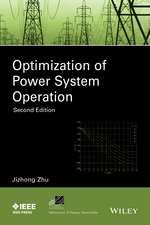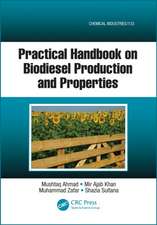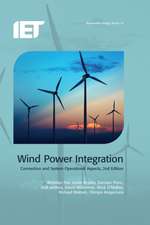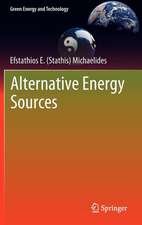The IEA/SSPS Solar Thermal Power Plants — Facts and Figures— Final Report of the International Test and Evaluation Team (ITET): Volume 4: Book of Summaries
Editat de Paul Kesselring, Clifford S. Selvageen Limba Engleză Paperback – feb 1986
Preț: 380.84 lei
Nou
Puncte Express: 571
Preț estimativ în valută:
72.90€ • 79.21$ • 61.27£
72.90€ • 79.21$ • 61.27£
Carte tipărită la comandă
Livrare economică 21 aprilie-05 mai
Preluare comenzi: 021 569.72.76
Specificații
ISBN-13: 9783540161493
ISBN-10: 354016149X
Pagini: 168
Ilustrații: VIII, 492 p. 14 illus.
Dimensiuni: 155 x 235 x 9 mm
Greutate: 0.25 kg
Ediția:1986
Editura: Springer Berlin, Heidelberg
Colecția Springer
Locul publicării:Berlin, Heidelberg, Germany
ISBN-10: 354016149X
Pagini: 168
Ilustrații: VIII, 492 p. 14 illus.
Dimensiuni: 155 x 235 x 9 mm
Greutate: 0.25 kg
Ediția:1986
Editura: Springer Berlin, Heidelberg
Colecția Springer
Locul publicării:Berlin, Heidelberg, Germany
Public țintă
ResearchCuprins
VOL I/1. Introduction.- VOL I/2. Central Receiver System.- VOL I/3. Historical Assessment of CRS Plant Performance and Operational Experiences.- 3.1 SSPS — CRS Plant History and 0peration(1981–1984).- 3.2 Daily Characteristics.- 3.3 Steam Generator Experiences.- 3.4 CRS Operational Experience.- VOL I/4. Heliostat Field Performance.- 4.1 Heliostat History and Status.- 4.2 Measurements and Calculations on Heliostat Field.- 4.3 10 MWe Solar Thermal CRS — Heliostat Evaluation.- VOL I/5. Receiver Behavior.- 5.1 Receiver Thermal Performance: Theory.- 5.2 Receiver Description: Billboard Receiver (ASR).- 5.3 Receiver Description: The Sulzer Cavity Receiver.- 5.4 Comparison of the Two Receivers.- 5.5 Efficiency and Temperature Measurements.- 5.6 Receiver Losses: Results of Tests.- 5.7 ASR Performances: Comparison With Simulation.- 5.8 Transient Response of the Sulzer Receiver.- 5.9 The SSPS Advanced Sodium Receiver: Transient Response.- 5.10 Differences Between Filling Strategies for the Sulzer and ASR Receivers.- 5.11 Results of the Performance of the Sulzer CavityReceiver and The Franco-Tosi External Receiver.- VOL I/6. Thermal Losses/Thermal Inertia.- 6.1 Losses of Piping and Tank.- 6.2 CRS Power Conversion System Losses.- 6.3 Remarks on Receiver Losses.- 6.4 CRS Parasitic Consumption: The Trace-Heating.- 6.5 Implication for Design and Operation.- VOL I/7. Systems Aspects/Control.- 7.1 Temperature Control of Solar Receiver’s.- 7.2 Sulzer Feedback Control Concepft.- 7.3 The Almeria Advanced Sodium Receiver: Dynamic Analysis and Control.- 7.4 Control of Incident Power tt the Receiver.- VOL I/8. Potential for Improvements.- 8.1 Improvements in Measurement Equipment.- 8.2 Potential for Improvements.- 8.3 Systems Considerations.- VOL II/2. Distributed Collector System.-VOL II/3. Historical Assessment of the Ssps-Dcs Plant Performance — Introduction.- 3.1 DCS — Operational Performances History.- 3.2 Input/Output Diagrams of the Solar Farm Systems.- 3.3 Evaluation of Third Field Performance.- 3.4 Comparison of MAN Fields’ Behavior.- 3.5 System Simulation.- VOL II/4. Survey of Plant Losses — Introduction.- 4.1 Optical Losses.- 4.2 Thermal Losses of the Collector Fiel’ds.- 4.3 The DCS Thermal Stratification Tank.- 4.4 Losses and Performance of the Power Conversion System.- 4.5 DCS Internal Electrical Consumption.- VOL II/5. Possibility of Automatic Control — Introduction.- 5.1 Temperature Regulation.- 5.2 Adaptive Control of the One-Axis Tracking Collector Field.- VOL II/6. Reliability — Availability — Maintenance Introduction.- 6.1 DCS Operational and Maintenance Experiences.- 6.2 Maintenance, Reliability, Avai1ability.- 6.3 Collector Field Maintenance: Distributed Solar Thermal Systems.- 6.4 Mirror Delami nation.- VOL II/7. Potential for Improvements.- 7.1 Potential For Improvements.- 7.2 Collector Fields: Potential For Improvements.- VOL III/2. Site Description.- VOL III/3. Meteorological Conditions.- 3.1 SSPS Meteorological Conditions 1982 — 1984.- VOL III/4. Environmental Conditions/Reflectivity.- 4.1 Environmental Condition Impacts on Solar Mirrow Reflectivity Degradation.- 4.2 Method for Estimating the Reflectivity Distribution.- VOL III/5. Soiling.- 5.1 Dust Analysis.- 5.2 Soiling Effects: Coating Investigations.- Appendices.- SSPS CRS Bibliography.- SSPS DCS Bibliography.- Solar Terminology.- Abbreviations.












